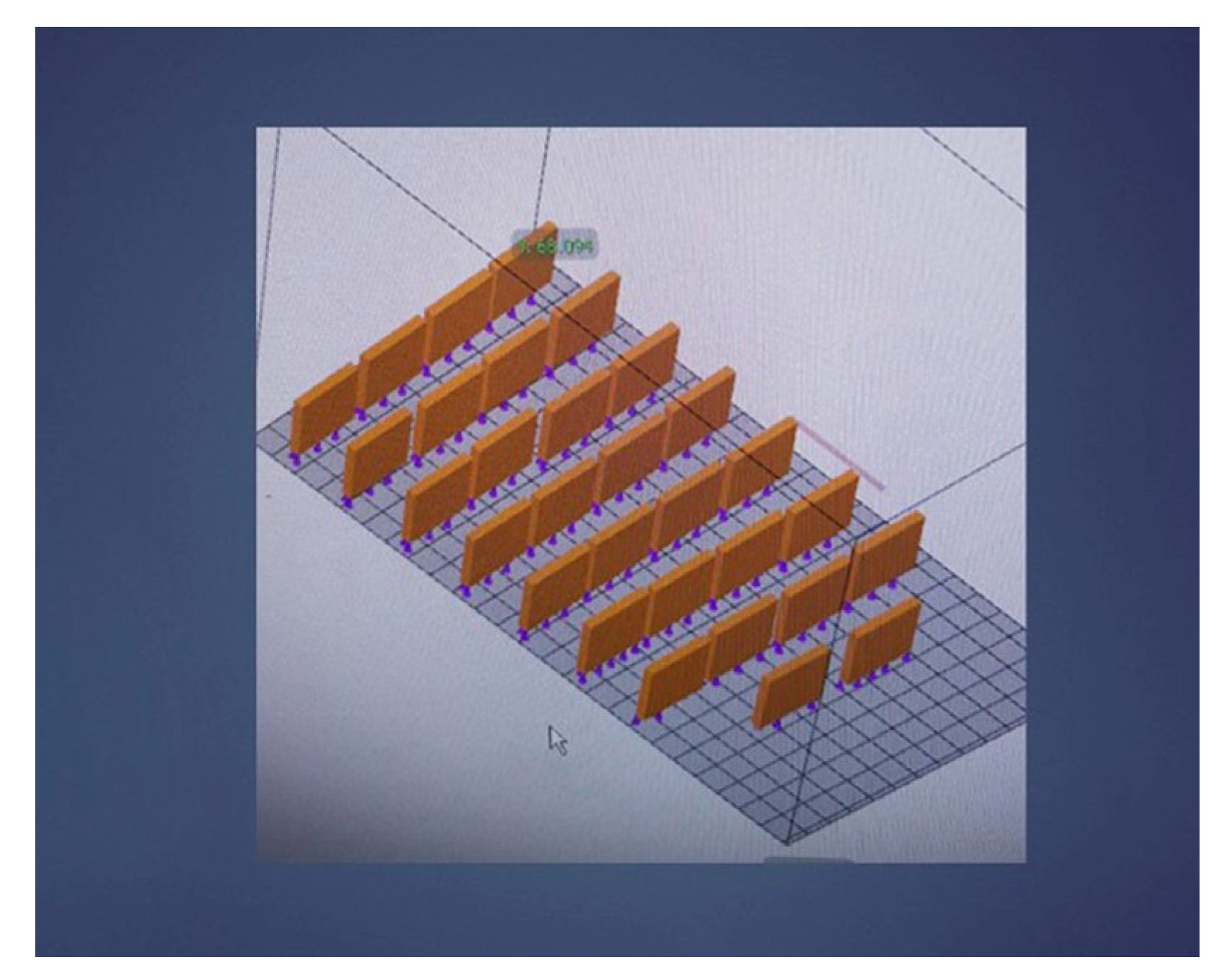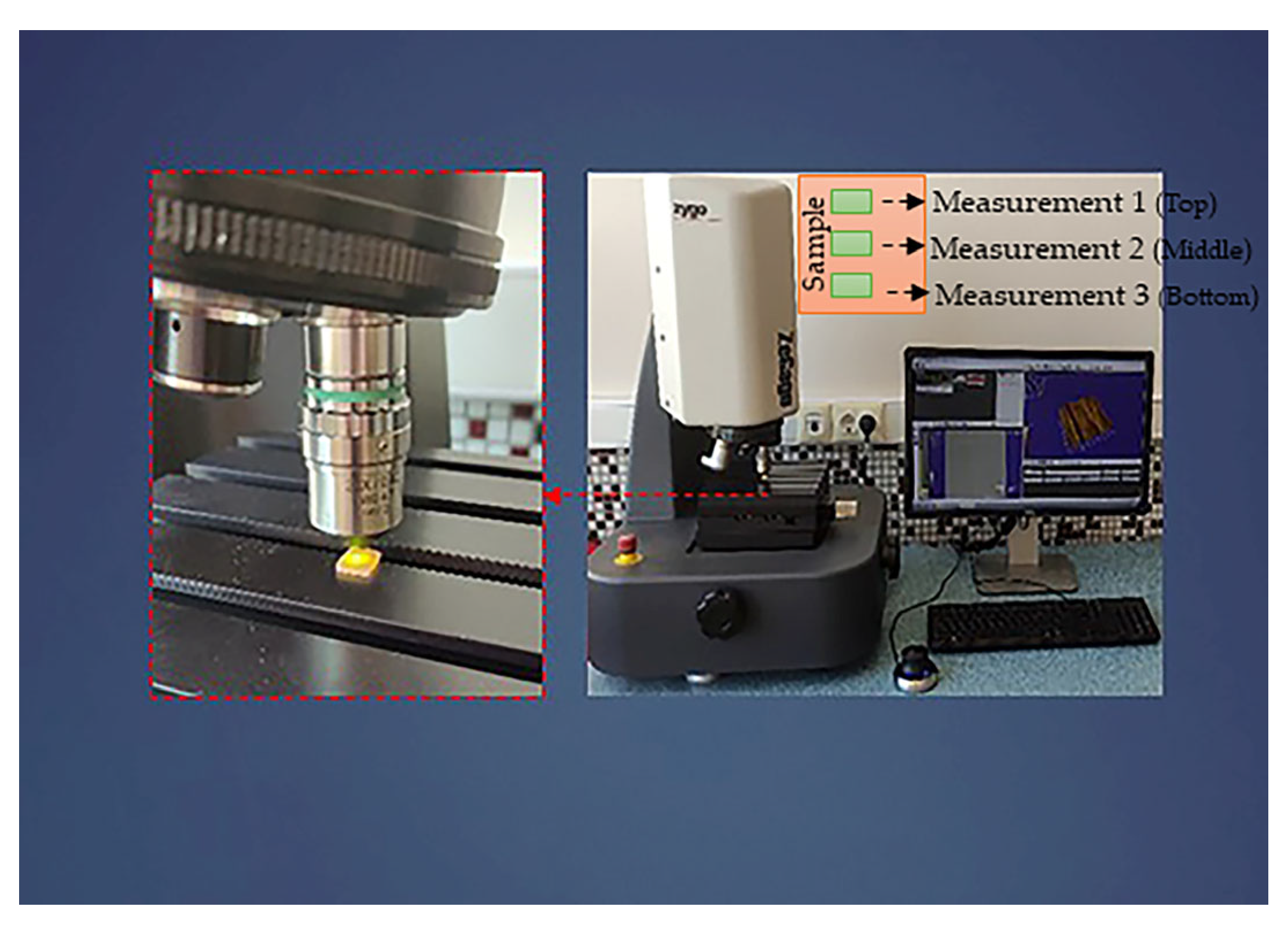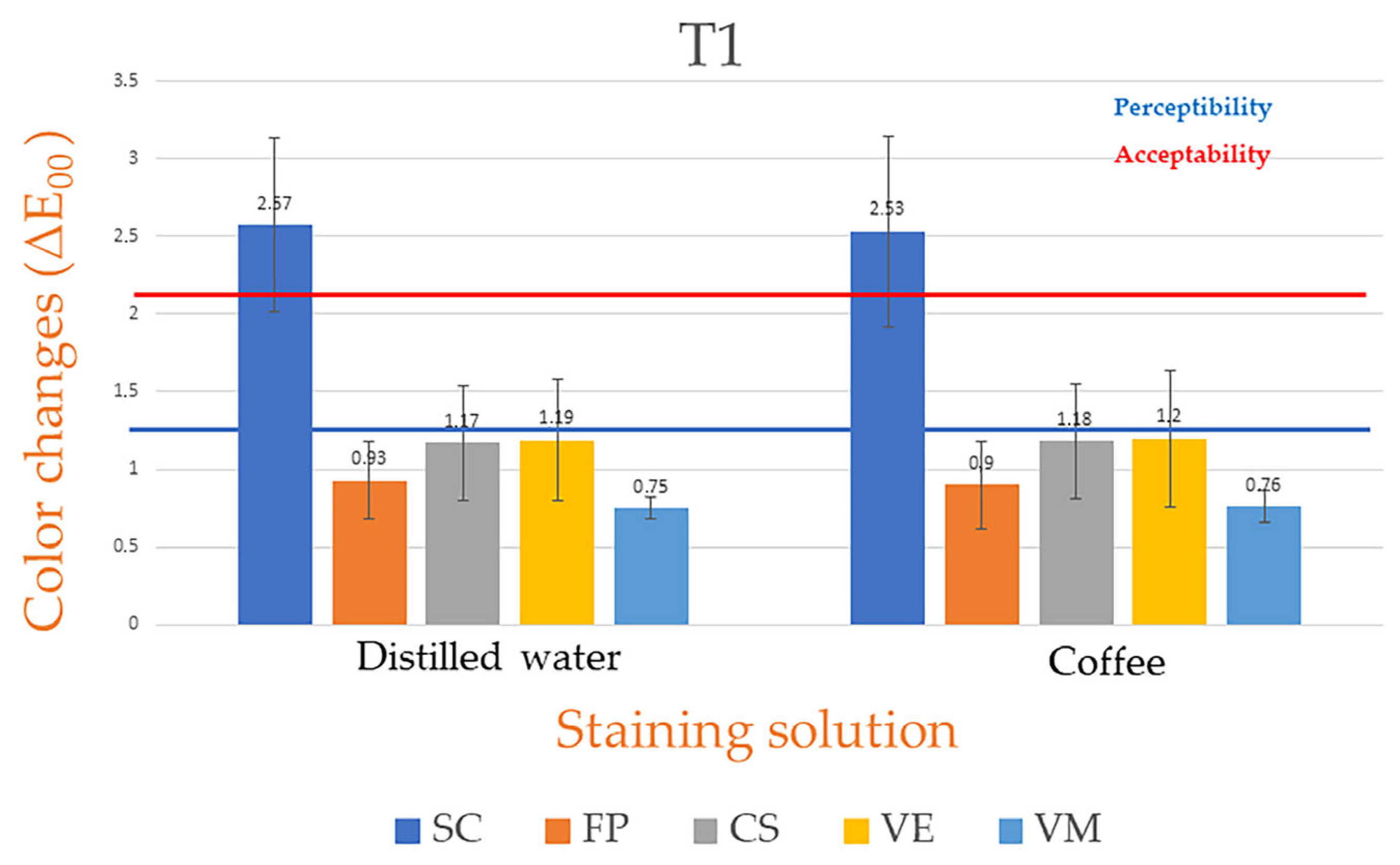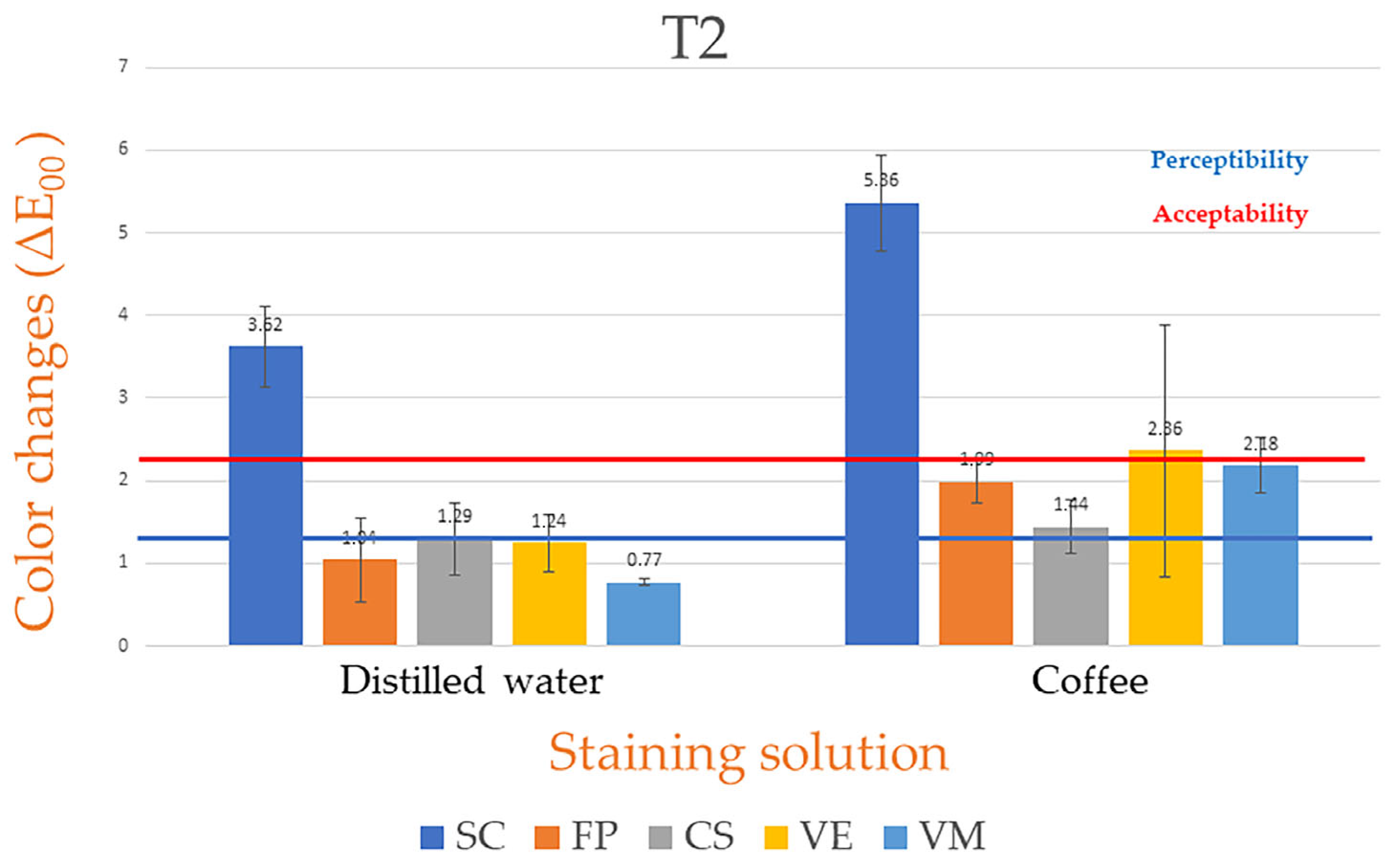Evaluation of the Color Stability, Stainability, and Surface Roughness of Permanent Composite-Based Milled and 3D Printed CAD/CAM Restorative Materials after Thermocycling
Abstract
1. Introduction
2. Materials and Methods
2.1. Preparation of Experimental Specimens
2.2. Measurement of Surface Roughness
2.3. Measurement of Color Parameters
2.4. Statistical Analysis
3. Results
4. Discussion
5. Conclusions
- (1)
- Among the investigated materials, while subtractively manufactured Vita Enamic exhibited the highest Ra value, additively manufactured Crowntec had the lowest Ra value after thermocycling. In addition, the tested additively manufactured composite resins and the subtractively manufactured Cerasmart 270 had similar mean Ra values. However, all investigated materials showed acceptable surface roughness after thermocycling that was equal to or below the plaque accumulation threshold of 0.2 µm.
- (2)
- The thermocycling increased the roughness of all tested materials. However, this increase was not significant.
- (3)
- Crowntec exhibited clinically unacceptable color changes at all intervals. On the contrary, Permanent Crown Resin exhibited a similar or lower color change compared to tested subtractively manufactured materials and glass ceramic. In addition, the color change of these materials was clinically acceptable, except for Vita Enamic in coffee.
- (4)
- Cerasmart 270 displayed the lowest color change in coffee, followed by the Permanent Resin Crown.
- (5)
- Finally, all tested permanent composite-based CAD-CAM restorative materials may provide acceptable surface roughness over long-term use. However, since Crowntec and Vita Enamic show unacceptable color changes, these materials may not be suitable for long-term use in clinical practice in areas where aesthetics are important.
Author Contributions
Funding
Institutional Review Board Statement
Informed Consent Statement
Data Availability Statement
Conflicts of Interest
References
- Vichi, A.; Balestra, D.; Scotti, N.; Louca, C.; Paolone, G. Translucency of CAD/CAM and 3D printable composite materials for permanent dental restorations. Polymers 2023, 15, 1443. [Google Scholar] [CrossRef] [PubMed]
- Tsolakis, I.A.; Gizani, S.; Panayi, N.; Antonopoulos, G.; Tsolakis, A.I. Three-dimensional printing technology in orthodontics for dental models: A systematic review. Children 2022, 9, 1106. [Google Scholar] [CrossRef] [PubMed]
- Dimitrova, M.; Chuchulska, B.; Zlatev, S.; Kazakova, R. Colour stability of 3D-printed and prefabricated denture teeth after immersion in different colouring agents—An in vitro study. Polymers 2022, 14, 3125. [Google Scholar] [CrossRef] [PubMed]
- Baldi, A.; Comba, A.; Tempesta, R.M.; Carossa, M.; Pereira, G.K.R.; Valandro, L.F.; Paolone, G.; Vichi, A.; Goracci, C.; Scotti, N. External marginal gap variation and residual fracture resistance of composite and lithium-silicate CAD/CAM overlays after cyclic fatigue over endodontically-treated molars. Polymers 2021, 13, 3002. [Google Scholar] [CrossRef] [PubMed]
- Kessler, A.; Hickel, R.; Reymus, M. 3D printing in dentistry-state of the art. Oper. Dent. 2020, 45, 30–40. [Google Scholar] [CrossRef]
- Infante, L.; Yilmaz, B.; McGlumphy, E.; Finger, I. Fabricating complete dentures with CAD/CAM technology. J. Prosthet. Dent. 2014, 111, 351–355. [Google Scholar] [CrossRef] [PubMed]
- Schweiger, J.; Stumbaum, J.; Edelhoff, D.; Güth, J.F. Systematics and concepts for the digital production of complete dentures: Risks and opportunities. Int. J. Comput. Dent. 2018, 21, 41–56. [Google Scholar] [PubMed]
- Al-Qarni, F.D.; Goodacre, C.J.; Kattadiyil, M.T.; Baba, N.Z.; Paravina, R.D. Stainability of acrylic resin materials used in CAD-CAM and conventional complete dentures. J. Prosthet. Dent. 2020, 123, 880–887. [Google Scholar] [CrossRef]
- Ngo, T.D.; Kashani, A.; Imbalzano, G.; Nguyen, K.T.; Hui, D. Additive manufacturing (3D printing): A review of materials, methods, applications and challenges. Compos. B Eng. 2018, 143, 172–196. [Google Scholar] [CrossRef]
- Yu, B.Y.; Son, K.; Lee, K.B. Evaluation of intaglio surface trueness and margin quality of interim crowns in accordance with the build angle of stereolithography apparatus 3-dimensional printing. J. Prosthet. Dent. 2022, 126, 231–237. [Google Scholar] [CrossRef]
- Lee, B.I.; You, S.G.; You, S.M.; Kang, S.Y.; Kim, J.H. Effect of rinsing time on the accuracy of interim crowns fabricated by digital light processing: An in vitro study. J. Adv. Prosthodont. 2021, 13, 24–35. [Google Scholar] [CrossRef] [PubMed]
- Zhang, Z.C.; Li, P.L.; Chu, F.T.; Shen, G. Influence of the three-dimensional printing technique and printing layer thickness on model accuracy. J. Orofac. Orthop. 2019, 80, 194–204. [Google Scholar] [CrossRef] [PubMed]
- You, S.G.; You, S.M.; Kang, S.Y.; Bae, S.Y.; Kim, J.H. Evaluation of the adaptation of complete denture metal bases fabricated with dental CAD-CAM systems: An in vitro study. J. Prosthet. Dent. 2021, 125, 479–485. [Google Scholar] [CrossRef] [PubMed]
- Comba, A.; Paolone, G.; Baldi, A.; Vichi, A.; Goracci, C.; Bertozzi, G.; Scotti, N. Effects of substrate and cement shade on the translucency and color of CAD/CAM lithium-disilicate and zirconia ceramic materials. Polymers 2022, 14, 1778. [Google Scholar] [CrossRef] [PubMed]
- Paolone, G.; Mandurino, M.; De Palma, F.; Mazzitelli, C.; Scotti, N.; Breschi, L.; Gherlone, E.; Cantatore, G.; Vichi, A. Color stability of polymer-based composite CAD/CAM blocks: A systematic review. Polymers 2023, 15, 464. [Google Scholar] [CrossRef] [PubMed]
- Flury, S.; Diebold, E.; Peutzfeldt, A.; Lussi, A. Effect of artificial toothbrushing and water storage on the surface roughness and micromechanical properties of tooth-colored CAD-CAM materials. J. Prosthet. Dent. 2017, 117, 767–774. [Google Scholar] [CrossRef] [PubMed]
- Dayan, S.Ç.; Emre, M. Effect of different storage media on the microhardness and wear resistance of resin-matrix ceramics. Int. J. Appl. Ceram. Technol. 2019, 16, 2467–2473. [Google Scholar] [CrossRef]
- Goujat, A.; Abouelleil, H.; Colon, P.; Jeannin, C.; Pradelle, N.; Seux, D.; Grosgogeat, B. Mechanical properties and internal fit of 4 CAD-CAM block materials. J. Prosthet. Dent. 2018, 119, 384–389. [Google Scholar] [CrossRef]
- Awada, A.; Nathanson, D. Mechanical properties of resin-ceramic CAD/CAM restorative materials. J. Prosthet. Dent. 2015, 114, 587–593. [Google Scholar] [CrossRef]
- Al-Qahtani, A.S.; Tulbah, H.I.; Binhasan, M.; Abbasi, M.S.; Ahmed, N.; Shabib, S.; Farooq, I.; Aldahian, N.; Nisar, S.S.; Tanveer, S.A.; et al. Surface properties of polymer resins fabricated with subtractive and additive manufacturing techniques. Polymers 2021, 13, 4077. [Google Scholar] [CrossRef]
- Della Bona, A.; Cantelli, V.; Britto, V.T.; Collares, K.F.; Stansbury, J.W. 3D printing restorative materials using a stereolithographic technique: A systematic review. Dent. Mater. 2021, 37, 336–350. [Google Scholar] [CrossRef] [PubMed]
- Alharbi, N.; Alharbi, A.; Osman, R. Stain susceptibility of 3D-printed nanohybrid composite restorative material and the efficacy of different stain removal techniques: An in vitro study. Materials 2021, 27, 5621. [Google Scholar] [CrossRef] [PubMed]
- Ellakany, P.; Fouda, S.M.; AlGhamdi, M.A.; Aly, N.M. Comparison of the color stability and surface roughness of 3-unit provisional fixed partial dentures fabricated by milling, conventional and different 3D printing fabrication techniques. J. Dent. 2023, 131, 104458. [Google Scholar] [CrossRef] [PubMed]
- Ardu, S.; Duc, O.; Krejci, I.; Bétrisey, E.; Di Bella, E.; Daher, R. Gloss retention of direct composites and corresponding CAD/CAM composite blocks. Clin. Exp. Dent. Res. 2022, 8, 282–286. [Google Scholar] [CrossRef]
- Egilmez, F.; Ergun, G.; Cekic-Nagas, I.; Vallittu, P.K.; Lassila, L.V.J. Comparative color and surface parameters of current esthetic restorative CAD/CAM materials. J. Adv. Prosthodont. 2018, 10, 32–42. [Google Scholar] [CrossRef] [PubMed]
- Alkhadim, Y.K.; Hulbah, M.J.; Nassar, H.M. Color shift, color stability, and post-polishing surface roughness of esthetic resin composites. Materials 2020, 13, 1376. [Google Scholar] [CrossRef] [PubMed]
- Al Amri, M.D.; Labban, N.; Alhijji, S.; Alamri, H.; Iskandar, M.; Platt, J.A. In vitro evaluation of translucency and color stability of CAD/CAM polymer-infiltrated ceramic materials after accelerated aging. J. Prosthodont. 2021, 30, 318–328. [Google Scholar] [CrossRef]
- Pettini, F.; Corsalini, M.; Savino, M.G.; Stefanachi, G.; Di Venere, D.; Pappalettere, C.; Monno, G.; Boccaccio, A. Roughness analysis on composite materials (microfilled, nanofilled and silorane) after different finishing and polishing procedures. Open Dent. J. 2015, 9, 357–367. [Google Scholar] [CrossRef]
- Dos Santos, P.H.; Catelan, A.; Albuquerque Guedes, A.P.; Umeda Suzuki, T.Y.; de Lima Godas, A.G.; Fraga Briso, A.L.; Bedran-Russo, A.K. Effect of thermocycling on roughness of nanofill, microfill and microhybrid composites. Acta Odontol. Scand. 2015, 73, 176–181. [Google Scholar] [CrossRef]
- Blackburn, C.; Rask, H.; Awada, A. Mechanical properties of resin-ceramic CAD-CAM materials after accelerated aging. J. Prosthet. Dent. 2018, 119, 954–958. [Google Scholar] [CrossRef]
- Subaşı, M.G.; Alp, G.; Johnston, W.M.; Yılmaz, B. Effects of fabrication and shading technique on the color and translucency of new-generation translucent zirconia after coffee thermocycling. J. Prosthet. Dent. 2018, 120, 603–608. [Google Scholar] [CrossRef] [PubMed]
- Yuan, J.C.; Barão, V.A.R.; Wee, A.G.; Alfaro, M.F.; Afshari, F.S.; Sukotjo, C. Effect of brushing and thermocycling on the shade and surface roughness of CAD-CAM ceramic restorations. J. Prosthet. Dent. 2018, 119, 1000–1006. [Google Scholar] [CrossRef] [PubMed]
- Mahrous, A.I.; Salama, A.A.; Shabaan, A.A.; Abdou, A.; Radwan, M.M. Color stability of two different resin matrix ceramics: Randomized clinical trial. BMC Oral Health 2023, 23, 665. [Google Scholar] [CrossRef] [PubMed]
- Stamenković, D.D.; Tango, R.N.; Todorović, A.; Karasan, D.; Sailer, I.; Paravina, R.D. Staining and aging-dependent changes in color of CAD-CAM materials. J. Prosthet. Dent. 2021, 126, 672–678. [Google Scholar] [CrossRef] [PubMed]
- Labban, N.; Al Amri, M.D.; Alnafaiy, S.M.; Alhijji, S.M.; Alenizy, M.A.; Iskandar, M.; Feitosa, S. Influence of toothbrush abrasion and surface treatments on roughness and gloss of polymer-infiltrated ceramics. Polymers 2021, 13, 3694. [Google Scholar] [CrossRef] [PubMed]
- Çakmak, G.; Oosterveen-Rüegsegger, A.L.; Akay, C.; Schimmel, M.; Yılmaz, B.; Dönmez, M.B. Influence of polishing technique and coffee thermal cycling on the surface roughness and color stability of additively and subtractively manufactured resins used for definitive restorations. J. Prosthodont. 2023, in press. [Google Scholar] [CrossRef] [PubMed]
- Donmez, M.B.; Okutan, Y. Marginal gap and fracture resistance of implant-supported 3D-printed definitive composite crowns: An in vitro study. J. Dent. 2022, 124, 104216. [Google Scholar] [CrossRef] [PubMed]
- Bozoğulları, H.N.; Büyükerkmen, E.B.; Büyüközer Özkan, H. Comparison of surface roughness and color stability of different denture characterizing composite resins: The effect of different surface treatments. J. Prosthodont. 2023, 32, 53–60. [Google Scholar] [CrossRef]
- Ardu, S.; Braut, V.; Gutemberg, D.; Krejci, I.; Dietschi, D.; Feilzer, A.J. A long-term laboratory test on staining susceptibility of esthetic composite resin materials. Quintessence Int. 2010, 41, 695–702. [Google Scholar]
- Dede, D.Ö.; Şahin, O.; Köroğlu, A.; Yılmaz, B. Effect of sealant agents on the color stability and surface roughness of nanohybrid composite resins. J. Prosthet. Dent. 2016, 116, 119–128. [Google Scholar] [CrossRef]
- Commission Internationale de l’Eclairage (CIE). CIE Technical Report: Colorimetry, 3rd ed.; CIE Central Bureau: Vienna, Austria, CIE Pub No.15; 2004. [Google Scholar]
- Shin, J.W.; Kim, J.E.; Choi, Y.J.; Shin, S.H.; Nam, N.E.; Shim, J.S.; Lee, K.W. Evaluation of the color stability of 3D-printed crown and bridge materials against various sources of discoloration: An in vitro study. Materials 2020, 26, 5359. [Google Scholar] [CrossRef]
- Quirynen, M.; Bollen, C.M.; Papaioannou, W.; Van Eldere, J.; van Steenberghe, D. The influence of titanium abutment surface roughness on plaque accumulation and gingivitis: Short-term observations. Int. J. Oral. Maxillofac. Implant. 1996, 11, 169–178. [Google Scholar]
- Zhi, L.; Bortolotto, T.; Krejci, I. Comparative in vitro wear resistance of CAD/CAM composite resin and ceramic materials. J. Prosthet. Dent. 2016, 115, 199–202. [Google Scholar] [CrossRef] [PubMed]
- Kim, J.E.; Choi, W.H.; Lee, D.; Shin, Y.; Park, S.H.; Roh, B.D.; Kim, D. Color and translucency stability of three-dimensional printable dental materials for crown and bridge restorations. Materials 2021, 14, 650. [Google Scholar] [CrossRef] [PubMed]
- Giordano, R. Materials for chairside CAD/CAM-produced restorations. J. Am. Dent. Assoc. 2006, 137 (Suppl. S1), 14S–21S. [Google Scholar] [CrossRef] [PubMed]
- Bellan, M.C.; Cunha, P.F.J.S.D.; Tavares, J.G.; Spohr, A.M.; Mota, E.G. Microtensile bond strength of CAD/CAM materials to dentin under different adhesive strategies. Braz. Oral. Res. 2017, 18, e109. [Google Scholar] [CrossRef] [PubMed]
- Bollen, C.M.; Papaioanno, W.; Van Eldere, J.; Schepers, E.; Quirynen, M.; van Steenberghe, D. The influence of abutment surface roughness on plaque accumulation and peri-implant mucositis. Clin. Oral. Implant. Res. 1996, 7, 201–211. [Google Scholar] [CrossRef] [PubMed]
- Stawarczyk, B.; Özcan, M.; Trottmann, A.; Schmutz, F.; Roos, M.; Hämmerle, C. Two-body wear rate of CAD/CAM resin blocks and their enamel antagonists. J. Prosthet. Dent. 2013, 109, 325–332. [Google Scholar] [CrossRef] [PubMed]
- Stawarczyk, B.; Sener, B.; Trottmann, A.; Roos, M.; Ozcan, M.; Hämmerle, C.H. Discoloration of manually fabricated resins and industrially fabricated CAD/CAM blocks versus glass-ceramic: Effect of storage media, duration, and subsequent polishing. Dent. Mater. J. 2012, 31, 377–383. [Google Scholar] [CrossRef] [PubMed]
- Della Bona, A.; Corazza, P.H.; Zhang, Y. Characterization of a polymer-infiltrated ceramic-network material. Dent. Mater. 2014, 30, 564–569. [Google Scholar] [CrossRef]
- Grzebieluch, W.; Kowalewski, P.; Grygier, D.; Rutkowska-Gorczyca, M.; Kozakiewicz, M.; Jurczyszyn, K. Printable and machinable dental restorative composites for CAD/CAM application-comparison of mechanical properties, fractographic, texture and fractal dimension analysis. Materials 2021, 14, 4919. [Google Scholar] [CrossRef] [PubMed]
- Alharbi, N.; Teerakanok, S.; Satterthwaite, J.D.; Giordano, R.; Silikas, N. Quantitative nano-mechanical mapping AFM-based method for elastic modulus and surface roughness measurements of model polymer infiltrated ceramics. Dent. Mater. 2022, 38, 935–945. [Google Scholar] [CrossRef] [PubMed]
- Fasbinder, D.J.; Neiva, G.F. Surface evaluation of polishing techniques for new resilient CAD/CAM restorative materials. J. Esthet. Restor. Dent. 2016, 28, 56–66. [Google Scholar] [CrossRef] [PubMed]
- Koizumi, H.; Saiki, O.; Nogawa, H.; Hiraba, H.; Okazaki, T.; Matsumura, H. Surface roughness and gloss of current CAD/CAM resin composites before and after toothbrush abrasion. Dent. Mater. J. 2015, 34, 881–887. [Google Scholar] [CrossRef] [PubMed]
- Grzebieluch, W.; Mikulewicz, M.; Kaczmarek, U. Resin composite materials for chairside cad/cam restorations: A comparison of selected mechanical properties. J. Healthc. Eng. 2021, 28, 8828954. [Google Scholar] [CrossRef] [PubMed]
- Ang, S.F.; Scholz, T.; Klocke, A.; Schneider, G.A. Determination of the elastic/plastic transition of human enamel by nanoindentation. Dent. Mater. 2009, 25, 1403–1410. [Google Scholar] [CrossRef] [PubMed]
- Kumari, C.M.; Bhat, K.M.; Bansal, R. Evaluation of surface roughness of different restorative composites after polishing using atomic force microscopy. J. Conserv. Dent. 2016, 19, 56–62. [Google Scholar] [CrossRef]
- Rinastiti, M.; Ozcan, M.; Siswomihardjo, W.; Busscher, H.J. Effects of surface conditioning on repair bond strengths of non-aged and aged microhybrid, nanohybrid, and nanofilled composite resins. Clin. Oral Investig. 2011, 15, 625–633. [Google Scholar] [CrossRef]
- Awad, D.; Stawarczyk, B.; Liebermann, A.; Ilie, N. Translucency of esthetic dental restorative CAD/CAM materials and composite resins with respect to thickness and surface roughness. J. Prosthet. Dent. 2015, 113, 534–540. [Google Scholar] [CrossRef]
- Ardu, S.; Gutemberg, D.; Krejci, I.; Feilzer, A.J.; Di Bella, E.; Dietschi, D. Influence of water sorption on resin composite color and color variation amongst various composite brands with identical shade code: An in vitro evaluation. J. Dent. 2011, 39 (Suppl. S1), e37–e44. [Google Scholar] [CrossRef]
- Dellazzana, F.Z.; Rodrigues, C.S.; Mallmann, A.; Jacques, L.B. Optical properties of a glass ceramic and an indirect resin composite: Effects of polishing and staining. J. Health Sci. 2019, 21, 512–517. [Google Scholar] [CrossRef]
- Mansouri, S.A.; Zidan, A.Z. Effect of water sorption and solubility on color stability of bulk-fill resin composite. J. Contemp. Dent. Pract. 2018, 9, 1129–1134. [Google Scholar]
- Gajewski, V.E.; Pfeifer, C.S.; Fróes-Salgado, N.R.; Boaro, L.C.; Braga, R.R. Monomers used in resin composites: Degree of conversion, mechanical properties and water sorption/solubility. Braz. Dent. J. 2012, 23, 508–514. [Google Scholar] [CrossRef]
- Van Noort, R. The future of dental devices is digital. Dent. Mater. 2012, 28, 3–12. [Google Scholar] [CrossRef] [PubMed]
- Kim, D.; Shim, J.S.; Lee, D.; Shin, S.H.; Nam, N.E.; Park, K.H.; Shim, J.S.; Kim, J.E. Effects of post-curing time on the mechanical and color properties of three-dimensional printed crown and bridge materials. Polymers 2020, 23, 2762. [Google Scholar] [CrossRef] [PubMed]
- Reymus, M.; Fabritius, R.; Keßler, A.; Hickel, R.; Edelhoff, D.; Stawarczyk, B. Fracture load of 3D-printed fixed dental prostheses compared with milled and conventionally fabricated ones: The impact of resin material, build direction, post-curing, and artificial aging-an in vitro study. Clin. Oral. Investig. 2020, 24, 701–710. [Google Scholar] [CrossRef] [PubMed]
- Reymus, M.; Lümkemann, N.; Stawarczyk, B. 3D-printed material for temporary restorations: Impact of print layer thickness and post-curing method on degree of conversion. Int. J. Comput. Dent. 2019, 22, 231–237. [Google Scholar] [PubMed]
- Lima, A.F.; Soares, G.P.; Vasconcellos, P.H.; Ambrosano, G.M.; Marchi, G.M.; Lovadino, J.R.; Aguiar, F.H. Effect of surface sealants on microleakage of Class II restorations after thermocycling and long-term water storage. J. Adhes. Dent. 2011, 13, 249–254. [Google Scholar]
- Chan, K.C.; Fuller, J.L.; Hormati, A.A. The ability of foods to stain two composite resins. J. Prosthet. Dent. 1980, 43, 542–545. [Google Scholar] [CrossRef]








| Material | Abbr. | Type | Manufacturer | Manufacturing Technique | Lot Number | Composition |
|---|---|---|---|---|---|---|
| Vita Mark II (control) | VM | Feldspathic glass ceramic | Vita Zahnfabrik, Bad Sackingen, Germany | Subtractive | 97190 | 20 wt% feldspathic particles with an average particle size of a 4 μm glassy matrix (80 wt%) |
| Vita Enamic | VE | Polymer infiltrated ceramic | Vita Zahnfabrik, Bad Sackingen, Germany | Subtractive | 99430 | UDMA, TEGDMA 14 wt% polymer, 86 wt% feldspar ceramic |
| Cerasmart 270 | CS | Resin nanoceramic | GC Corp., Tokyo, Japan | Subtractive | 1910017 | Bis-MEPP, UDMA, DMA, silica (20 nm), barium glass (300 nm) 71 wt% |
| Crowntec | SC | Composite-based resin | Saremco, Dental AG, Rebstein, Switzerland | Additive (DLP) | E308 | Bis-EMA %50–<70 Trimethylbenzonyl diphenylphosphine oxide %0.1–<1 |
| Permanent Crown Resin | FP | Composite-based resin | Formlabs Inc., Somerville, MA, USA | Additive (SLA) | 600394 | (Bis-EMA, methacrylate polymer)4′-isopropylidiphenol, ethoxylated and 2-methylprop-2enoic acid Methyl benzoylformate, silanized dental glass, diphenyl (30–50 wt% inorganic fillers 2,4,6-trimethylbenzoyl) phosphine oxide. |
| Sum of Squares | df | Mean of Squares | F | p * | |
|---|---|---|---|---|---|
| Between groups | 0.138 | 4 | 0.035 | 51.974 | 0 |
| Within groups | 0.03 | 45 | 0.001 | ||
| Total | 0.168 | 49 |
| Sum of Squares | df | Mean of Squares | F | p * | |
|---|---|---|---|---|---|
| Between groups | 0.201 | 4 | 0.050 | 87.281 | 0.000 |
| Within groups | 0.026 | 45 | 0.001 | ||
| Total | 0.227 | 49 |
| Groups | Ra0 | Tukey * | Ra1 | Tukey * | t-Test (p) ** |
|---|---|---|---|---|---|
| Mean ± SD | Mean ± SD | ||||
| SC | 0.039 ± 0.005 | A | 0.038 ± 0.007 | A | p = 0.642 |
| FP | 0.044 ± 0.004 | A | 0.045 ± 0.009 | A | p = 0.709 |
| CS | 0.037 ± 0.008 | A | 0.041 ± 0.008 | A | p = 0.482 |
| VE | 0.174 ± 0.043 | B | 0.201 ± 0.041 | B | p = 0.170 |
| VM | 0.096 ± 0.035 | C | 0.115 ± 0.031 | C | p = 0.283 |
| Material | ||||||
|---|---|---|---|---|---|---|
| SC | FP | CS | VE | VM | ||
| Mean ± SD | Mean ± SD | Mean ± SD | Mean ± SD | Mean ± SD | ||
| T1 | Distilled water | 2.57 ± 0.56 a | 0.93 ± 0.25 bc | 1.17 ± 0.37 b | 1.19 ± 0.39 b | 0.75 ± 0.07 c |
| Coffee | 2.53 ± 0.61 a | 0.90 ± 0.28 bc | 1.18 ± 0.37 d | 1.20 ± 0.44 bd | 0.76 ± 0.10 c | |
| T2 | Distilled water | 3.62 ± 0.48 aB | 1.04 ± 0.51 bcB | 1.29 ± 0.43 bcB | 1.24 ± 0.34 bB | 0.77 ± 0.04 cB |
| Coffee | 5.36 ± 0.58 aC | 1.99 ± 0.26 bC | 1.44 ± 0.33 cB | 2.36 ± 1.53 bB | 2.18 ± 0.34 bC | |
| +p | Distilled water | 0.005 | 0.721 | 0.515 | 0.799 | 0.074 |
| Coffee | 0.005 | 0.005 | 0.202 | 0.019 | 0.005 | |
Disclaimer/Publisher’s Note: The statements, opinions and data contained in all publications are solely those of the individual author(s) and contributor(s) and not of MDPI and/or the editor(s). MDPI and/or the editor(s) disclaim responsibility for any injury to people or property resulting from any ideas, methods, instructions or products referred to in the content. |
© 2023 by the authors. Licensee MDPI, Basel, Switzerland. This article is an open access article distributed under the terms and conditions of the Creative Commons Attribution (CC BY) license (https://creativecommons.org/licenses/by/4.0/).
Share and Cite
Bozoğulları, H.N.; Temizci, T. Evaluation of the Color Stability, Stainability, and Surface Roughness of Permanent Composite-Based Milled and 3D Printed CAD/CAM Restorative Materials after Thermocycling. Appl. Sci. 2023, 13, 11895. https://doi.org/10.3390/app132111895
Bozoğulları HN, Temizci T. Evaluation of the Color Stability, Stainability, and Surface Roughness of Permanent Composite-Based Milled and 3D Printed CAD/CAM Restorative Materials after Thermocycling. Applied Sciences. 2023; 13(21):11895. https://doi.org/10.3390/app132111895
Chicago/Turabian StyleBozoğulları, Hatice Nalan, and Tuğba Temizci. 2023. "Evaluation of the Color Stability, Stainability, and Surface Roughness of Permanent Composite-Based Milled and 3D Printed CAD/CAM Restorative Materials after Thermocycling" Applied Sciences 13, no. 21: 11895. https://doi.org/10.3390/app132111895
APA StyleBozoğulları, H. N., & Temizci, T. (2023). Evaluation of the Color Stability, Stainability, and Surface Roughness of Permanent Composite-Based Milled and 3D Printed CAD/CAM Restorative Materials after Thermocycling. Applied Sciences, 13(21), 11895. https://doi.org/10.3390/app132111895






